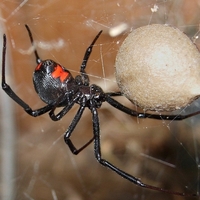The southern black widow, as its name implies, resides primarily in the southeastern United States (including Charlotte, Raleigh, and Wilmington, NC!).
The black widow gets its name from the misconception that the female eats the male after mating.
How to Identify Black Widow Spiders

The Biology of Black Widow Spiders
This spider spends most of its time on a web that it has usually built in a corner. It spends this time upside down waiting for its prey to be trapped in its web. The female spider produces a sac which holds its eggs. This egg sac contains 100-900 eggs. A female can produce from 4-9 egg sacs each summer, and since she is able to live for 5 years, she can lay up to 20 – 45 sacs in her lifetime, producing more than 40,000 total eggs.
A web can contain 2 sacs (produced in about 1-3 hours; when freshly laid, the egg sac is pure white but will change to light tan in a few hours), but usually, there is only one egg sac placed in the middle of the web. The eggs hatch in the sac. If you look closely, you can sometimes see the spiderlings on the web. Spiderlings emerge from the sac after the second molt. At each molt, they change colorations and patterns. After the 2nd molt, the spiderlings have the ability to produce silk strands that enable them to catch air currents and float with the wind to their new home. This is known as “ballooning” or “dynamic kiting” (see E. B. White’s charming tale “Charlotte’s Web”). They overwinter and develop into adults in the spring.
Where do you See Black Widow Spiders?
- The black widow spider builds an irregular web in which she hangs upside-down.
- Webs are constructed in secluded spots such as woodpiles, hollow tree stumps, rodent burrows, overgrown areas and under stones.
- The spider herself is mostly shy unless defending her eggs, generally avoids light and many times you will not see her but recognize her only by her web.
- She is much more active at night. In addition to the sites mentioned above, she seems to like man-made structures best: sheds, outdoor privies, meter boxes, drain lines, etc.
Feeding Preferences of Black Widow Spiders
Black widow spiders typically feed on other insects. When insects are captured, she swiftly moves in to wrap the prey then inject the prey with her venom. After about 10 minutes the prey is subdued and the black widow retreats to a more protected area to feed.
Ways to reduce the conditions that harbor and attract black widows:
- Repair or install tight-fitting screens on windows, doors, gables, foundation and soffit vents
- Install weather stripping and door sweeps
- Seal gaps around doors and windows
- Repair foundation cracks
- Seal around HVAC systems
- Install yellow or sodium lights since these attract fewer insects, which are the spiders’ food source
- Seal stored items in tight-fitting plastic containers in basements, garages and storage units
- Seek professional assistance and a pest prevention plan
Ways to reduce spider bites:
- Inspect clothing and shoes before getting dressed
- Remove all spider webs, especially under beds, nightstands and in clothes closets
- Move beds away from walls
- Use gloves when moving stored items, working in the garden, moving firewood, etc.
- Store items off of the floor
- Remove or discard unwanted items
- Move firewood away from home
Economy Exterminators’ Pest Control Solutions program uses the 4-step approach to solve your black widow spider pest problem:
- Our 1st step is the inspection of the property by a Wilmington, Charlotte or Raleigh customer service specialist. It is very important to know the species of spider involved and the severity of the pest problem.
- The 2nd step is the initial treatment by a customer service specialist of all areas that the inspection revealed as critical. Economy Exterminators uses the newest and most effective materials to solve this pest problem fast for you. Critical areas are typically the inside of the structure, storage areas, crawlspaces, attics, and garages. Our Pest Control Solutions program includes not only the treatment of these spiders but also the sweeping down and the removal of these spider webs on the inside and outside of the home. This helps to reduce the next generation since spider web removal will remove the eggs sacs as well. Your inspector and/or technician will be able to advise you at no additional charge on any additional treatments necessary. On the exterior of the building, special attention will be applied to all the windows, doors, eaves and the foundations.
- The 3rd step is a 37-point inspection of your property to identify areas that give black widow spiders easy access by either direct access (cracks in the foundation) or by other areas where the spider may be found.
- The 4th step is an ongoing maintenance program for the next generation. New black widow infestations will be moving on your property by ballooning from your trees or from the adjoining property. Our exclusive Pest Control Solutions program is designed to help prevent the next generation of spiders.
- As always our unlimited extra service is provided at no charge to you.




